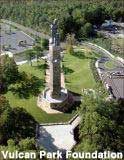nBirmingham.net
Vulcan in Birmingham Alabama
On the summit of Red Mountain, overlooking the heart of downtown Birmingham, stands a 56-foot statue of Vulcan, the Roman god of fire (aka God of the Forge). What is this pagan colossus doing on the virtual buckle of the Bible Belt?
Vulcan was sculpted by artist Giuseppe Moretti for steel town Birmingham as an exhibit for the Palace of Mines and Metallurgy at the 1904 St. Louis World's Fair. He was (and still is) the world's largest cast metal statue and the largest statue ever made in the U.S. His height was originally planned for 50 feet, but when Birmingham learned that a pagan Buddha in Tokyo stood 52 feet tall, they made their pagan Vulcan four feet taller.
After the Fair, Vulcan was returned to Birmingham, with the expectation that he would be erected in downtown. No way, said the citizens of Birmingham. We don't mind that he's a pagan god, but he's practically NUDE! Vulcan was placed back in his crate and shipped into exile to the state fair grounds. Once there, pragmatic officials painted a pair of blue overalls on him and used his empty left hand — which had once held a spear — to display a giant Coke bottle.
With time, the passions surrounding Vulcan faded (as did his blue coveralls). He was finally shipped back to Birmingham in 1937 and erected on Red Mountain -- the very mountain from which his iron body had been mined. He currently stands atop a 124 foot pedestal/observation deck, which removes his nakedness to a safe distance and makes good photos nearly impossible.
Birmingham's Jaycees added a touch in the 1940s. Vulcan held a neon "safety torch" for over 50 years, which would turn from its normal green to red whenever there was a traffic fatality in metro Birmingham.
 |
In 1999, Vulcan became a potential safety hazard himself, when cracks were noticed in his structure, believed brought on by previously flawed efforts at preservation. Drastic steps needed to be taken, and Vulcan was disassembled and underwent repairs for five years. He returned to public view in 2004, atop a new Vulcan Center and pedestal restored to its 1938 appearance.
Visitors to Vulcan Center find interactive exhibits and displays that give insight into Birmingham's history and industrial growth. Vulcan no longer holds the safety torch -- it's exhibited in the museum, and lights up at the touch of a button.